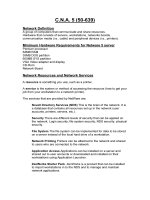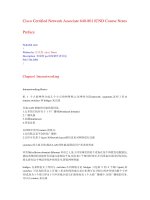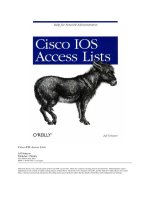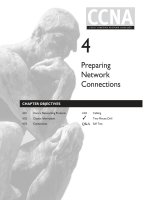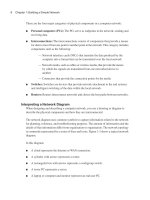Tài liệu Cisco - Network Consultants Handbook pptx
Bạn đang xem bản rút gọn của tài liệu. Xem và tải ngay bản đầy đủ của tài liệu tại đây (7.8 MB, 1,259 trang )
Network Consultants Handbook
About the Author.......................................................................................................................................................................... 10
About the Technical Reviewers .................................................................................................................................................. 11
Acknowledgments ....................................................................................................................................................................... 12
Foreword ...................................................................................................................................................................................... 13
Introduction................................................................................................................................................................................... 14
Purpose of This Book................................................................................................................................................................. 16
How This Book Can Be Used..................................................................................................................................................... 17
The Twelve Networking Truths.................................................................................................................................................. 17
Feedback.................................................................................................................................................................................... 19
Chapter 1. Open System Interconnection (OSI) Model........................................................................................................... 20
OSI Reference Model................................................................................................................................................................. 20
Summary.................................................................................................................................................................................... 31
Chapter 2. LAN Topologies ........................................................................................................................................................ 32
Unicast....................................................................................................................................................................................... 32
Multicast .................................................................................................................................................................................... 33
Broadcast ................................................................................................................................................................................... 34
LAN Addressing ........................................................................................................................................................................ 38
LAN Topologies......................................................................................................................................................................... 39
LAN Topologies......................................................................................................................................................................... 47
Routers....................................................................................................................................................................................... 56
Summary.................................................................................................................................................................................... 56
Chapter 3. Ethernet/IEEE 802.3................................................................................................................................................. 58
Ethernet Network Elements........................................................................................................................................................ 62
Ethernet Network Topologies and Structures.............................................................................................................................. 63
IEEE 802.3 Logical Relationship to the OSI Reference Model ................................................................................................... 65
CSMA/CD Operation................................................................................................................................................................... 71
The Ethernet Physical Layers ..................................................................................................................................................... 82
10 Mbps Ethernet Operation....................................................................................................................................................... 83
100 Mbps, or Fast Ethernet......................................................................................................................................................... 92
100VG-AnyLAN........................................................................................................................................................................ 99
1000 Mbps, or Gigabit (Gbps) Ethernet.................................................................................................................................... 104
10 Gbps, or 10 Gigabit Ethernet ............................................................................................................................................... 107
Summary.................................................................................................................................................................................. 113
Chapter 4. Ethernet Documentation........................................................................................................................................ 113
Case Study: Naming Conventions............................................................................................................................................. 114
Small Ethernet (Hub-Based) Networks..................................................................................................................................... 117
Documentation Case Study....................................................................................................................................................... 121
Summary.................................................................................................................................................................................. 150
Chapter 5. Ethernet Network Review and Analysis ............................................................................................................... 150
Cisco Router Interface Commands ........................................................................................................................................... 151
show interface ethernet number accounting .............................................................................................................................. 170
show buffers ethernet ............................................................................................................................................................... 173
Buffer Misses ........................................................................................................................................................................... 177
show processes cpu .................................................................................................................................................................. 179
CPU Utilization........................................................................................................................................................................ 181
Ethernet Network Analysis....................................................................................................................................................... 182
Ethernet Frame Transmission ................................................................................................................................................... 182
Ethernet Baseline...................................................................................................................................................................... 187
Ethernet MTU .......................................................................................................................................................................... 191
Ethernet Throughput................................................................................................................................................................. 192
Ethernet Effective Utilization ................................................................................................................................................... 195
Ethernet with IP Networking .................................................................................................................................................... 197
Ethernet with IPX Networking ................................................................................................................................................. 204
Case Study: Ethernet Network Analyzers ................................................................................................................................. 211
Summary.................................................................................................................................................................................. 216
Chapter 6. Token Ring/IEEE 802.5 ......................................................................................................................................... 221
Token Ring .............................................................................................................................................................................. 221
Physical Connections................................................................................................................................................................ 224
Token Ring Operation.............................................................................................................................................................. 225
Token Holding Time (THT) ..................................................................................................................................................... 233
Frame Format........................................................................................................................................................................... 239
Dedicated Token Ring.............................................................................................................................................................. 243
Summary.................................................................................................................................................................................. 247
Chapter 7. FDDI......................................................................................................................................................................... 248
Fiber-Optic Transmission Modes.............................................................................................................................................. 249
FDDI Topology........................................................................................................................................................................ 250
FDDI LAN Applications .......................................................................................................................................................... 261
Summary.................................................................................................................................................................................. 261
Chapter 8. Token Ring and FDDI LAN Documentation......................................................................................................... 262
Case Study: Naming Conventions............................................................................................................................................. 264
Case Study: Simple Token Ring LAN ...................................................................................................................................... 267
Case Study: Simple FDDI LAN................................................................................................................................................ 271
Summary.................................................................................................................................................................................. 275
Chapter 9. Token Ring and FDDI Network Review and Analysis......................................................................................... 275
Token Ring LANs.................................................................................................................................................................... 276
FDDI LANs ............................................................................................................................................................................. 312
FDDI LANs ............................................................................................................................................................................. 348
Summary.................................................................................................................................................................................. 385
Chapter 10. ATM LAN Emulation (LANE)............................................................................................................................... 385
Emulated LAN Environments................................................................................................................................................... 387
LAN Emulation Clients (LECs)................................................................................................................................................ 394
LAN Emulation Servers (LESs)................................................................................................................................................ 395
LAN Emulation Applications ................................................................................................................................................... 417
Summary.................................................................................................................................................................................. 418
Chapter 11. ATM LANE Documentation, Review, and Analysis........................................................................................... 419
Effective Operating Rate .......................................................................................................................................................... 420
ATM LANE Traffic Classes..................................................................................................................................................... 421
IOS Commands........................................................................................................................................................................ 427
ATM LANE Documentation .................................................................................................................................................... 443
Summary.................................................................................................................................................................................. 450
Chapter 12. Telecommunications and Telephony ................................................................................................................. 451
Voice Signaling........................................................................................................................................................................ 451
ANI.......................................................................................................................................................................................... 460
Lines and Trunks...................................................................................................................................................................... 463
ISDN........................................................................................................................................................................................ 473
DSL.......................................................................................................................................................................................... 483
Summary.................................................................................................................................................................................. 494
Chapter 13. Private Line WANs............................................................................................................................................... 496
T1 Basics ................................................................................................................................................................................. 496
TDM........................................................................................................................................................................................ 500
T1 Documentation.................................................................................................................................................................... 515
T1 Access................................................................................................................................................................................. 520
T1 Testing and Analysis........................................................................................................................................................... 523
DS0 Basics............................................................................................................................................................................... 526
DS3.......................................................................................................................................................................................... 530
Summary.................................................................................................................................................................................. 533
Chapter 14. Fiber-Optic Technology ....................................................................................................................................... 534
Optic Bands and Transmission Windows.................................................................................................................................. 536
SONET/SDH............................................................................................................................................................................ 541
DWDM .................................................................................................................................................................................... 550
Summary.................................................................................................................................................................................. 554
Chapter 15. Frame Relay ......................................................................................................................................................... 557
Frame Relay Terms and Concepts ............................................................................................................................................ 559
Frame Relay Applications ........................................................................................................................................................ 599
Frame Relay Traffic Shaping.................................................................................................................................................... 631
Traffic Policing and Shaping .................................................................................................................................................... 639
Summary.................................................................................................................................................................................. 651
Chapter 16. Frame Relay Documentation............................................................................................................................... 656
Case Study: Naming Conventions............................................................................................................................................. 658
Frame Relay DLCI Table ......................................................................................................................................................... 697
Summary.................................................................................................................................................................................. 700
Chapter 17. Frame Relay WAN Analysis................................................................................................................................ 702
Frame Relay Traffic Shaping.................................................................................................................................................... 702
Frame Relay Oversubscription.................................................................................................................................................. 708
Frame Relay Data Delivery Ratio (DDR) ................................................................................................................................. 713
Frame Relay SLAs ................................................................................................................................................................... 719
Summary.................................................................................................................................................................................. 720
Chapter 18. ATM Wide-Area Networking (WAN) and MPOA ............................................................................................... 722
ATM Network Architecture ..................................................................................................................................................... 725
ATM WAN Interfaces.............................................................................................................................................................. 727
PNNI Signaling........................................................................................................................................................................ 732
ATM Connections.................................................................................................................................................................... 733
ATM Cells and Cell Relay........................................................................................................................................................ 734
ATM Service Classes ............................................................................................................................................................... 736
ATM Service Architecture........................................................................................................................................................ 737
ATM Service Categories Description ....................................................................................................................................... 741
ATM Functional Layers ........................................................................................................................................................... 748
ATM Addressing...................................................................................................................................................................... 755
ATM Applications.................................................................................................................................................................... 757
Multiprotocol Over ATM (MPOA)........................................................................................................................................... 761
Three Elements of MPOA ........................................................................................................................................................ 763
MPOA Logical Components .................................................................................................................................................... 765
Caching.................................................................................................................................................................................... 766
Virtual Subnets......................................................................................................................................................................... 766
Network Layer Mapping........................................................................................................................................................... 767
Taking a Shortcut: The Basic Concept...................................................................................................................................... 768
MPOA Packet Flow.................................................................................................................................................................. 770
Migration and Coexistence....................................................................................................................................................... 772
Inverse Multiplexing for ATM (IMA) ...................................................................................................................................... 773
Summary.................................................................................................................................................................................. 775
Chapter 19. ATM WAN Documentation .................................................................................................................................. 777
Case Study: Naming Conventions............................................................................................................................................. 778
ATM VPI/VCI Table................................................................................................................................................................ 804
Summary.................................................................................................................................................................................. 807
Chapter 20. Voice Technology................................................................................................................................................. 807
VoIP Network Elements........................................................................................................................................................... 808
Session Initiation Protocol (SIP)............................................................................................................................................... 839
VoIP Equipment Adjustment.................................................................................................................................................... 844
VoX Call Establishment ........................................................................................................................................................... 848
VoX Summary ......................................................................................................................................................................... 849
Voice over ATM (VoATM)...................................................................................................................................................... 850
VoATM Expectations............................................................................................................................................................... 861
VoATM Summary.................................................................................................................................................................... 870
Voice over Frame Relay (VoFR).............................................................................................................................................. 871
VoIP......................................................................................................................................................................................... 876
VoX Circuit Sizing................................................................................................................................................................... 877
Summary.................................................................................................................................................................................. 880
Chapter 21. Remote Access and VPNs .................................................................................................................................. 882
Remote Access......................................................................................................................................................................... 882
LAN-to-LAN VPN................................................................................................................................................................... 890
Authentication.......................................................................................................................................................................... 890
Encryption Alternatives............................................................................................................................................................ 898
Telecommunications Access Methods to a Local ISP ............................................................................................................... 907
Policy and Administrative Management ................................................................................................................................... 910
VPN Network Requirements .................................................................................................................................................... 916
Remote Access VPN Network Design...................................................................................................................................... 922
VPN User-Access Requirements .............................................................................................................................................. 927
VPN Performance Requirements.............................................................................................................................................. 928
VPN Client Essentials, Security Guidelines, and Vulnerabilities............................................................................................... 931
DHCP Support......................................................................................................................................................................... 936
Summary.................................................................................................................................................................................. 938
Chapter 22. Network Management Introduction..................................................................................................................... 938
Network Management Architecture.......................................................................................................................................... 939
Network Management Model ................................................................................................................................................... 941
Network Management Functional Architecture......................................................................................................................... 953
MIB.......................................................................................................................................................................................... 957
Summary.................................................................................................................................................................................. 965
Chapter 23. IP VPN WAN Documentation.............................................................................................................................. 967
Remote Access Documentation Template................................................................................................................................. 969
IOS Commands........................................................................................................................................................................ 977
Summary.................................................................................................................................................................................. 982
Chapter 24. Routing Protocols, Part I .................................................................................................................................... 982
Routing: Static Versus Dynamic............................................................................................................................................... 983
Routing Information Protocol (RIP).......................................................................................................................................... 991
RIP Routing Protocol Summary.............................................................................................................................................. 1006
RIP Version 2 (RIPv2) ........................................................................................................................................................... 1006
RIPv2 Summary..................................................................................................................................................................... 1010
IGRP...................................................................................................................................................................................... 1010
IGRP Summary...................................................................................................................................................................... 1020
EIGRP.................................................................................................................................................................................... 1021
EIGRP Summary.................................................................................................................................................................... 1028
OSPF...................................................................................................................................................................................... 1029
OSPF Summary...................................................................................................................................................................... 1042
Summary................................................................................................................................................................................ 1042
Chapter 25. Routing Protocols, Part II................................................................................................................................... 1047
Intermediate System to Intermediate System (IS-IS)............................................................................................................... 1047
IS-IS Summary....................................................................................................................................................................... 1057
Border Gateway Protocol, Version 4 (BGP4).......................................................................................................................... 1058
BGP Summary ....................................................................................................................................................................... 1082
EGP........................................................................................................................................................................................ 1086
EGP Summary........................................................................................................................................................................ 1088
Summary............................................................................................................................................................................... 1089
Chapter 26. IPv6 Introduction................................................................................................................................................. 1091
IPv6 Terms............................................................................................................................................................................. 1095
IPv6 Addressing..................................................................................................................................................................... 1096
IPv6 Neighbor Discover Protocol (NDP)................................................................................................................................ 1109
IPv4/IPv6 Transition .............................................................................................................................................................. 1110
IPv4/IPv6 Network Address Translation (NAT) ..................................................................................................................... 1112
IPv6 Header ........................................................................................................................................................................... 1112
IPv6/IPv4 Tunneling .............................................................................................................................................................. 1115
6to4 Tunnel Management....................................................................................................................................................... 1117
6to4 Case Study...................................................................................................................................................................... 1118
Summary................................................................................................................................................................................ 1126
Chapter 27. Multiprotocol Label Switching (MPLS).............................................................................................................. 1127
Label-Edge Routers (LERs) and Label\_Switching Routers (LSRs)........................................................................................ 1129
Forward Equivalence Classes (FECs) ..................................................................................................................................... 1129
Labels and Label Bindings ..................................................................................................................................................... 1130
MPLS Fundamentals............................................................................................................................................................. 1131
Multilayer Switching.............................................................................................................................................................. 1134
MPLS Evolution..................................................................................................................................................................... 1139
MPLS Model.......................................................................................................................................................................... 1140
MPLS and Layer 3 Forwarding .............................................................................................................................................. 1143
MPLS Operation .................................................................................................................................................................... 1144
MPLS Enhanced Routing ....................................................................................................................................................... 1147
MPLS Applications................................................................................................................................................................ 1148
MPLS Virtual Private Networks (MPLS-VPNs)..................................................................................................................... 1152
IP/MPLS Network.................................................................................................................................................................. 1154
BGP-Extended Community Attributes.................................................................................................................................... 1155
MPLS VPN Operational Model.............................................................................................................................................. 1156
Summary................................................................................................................................................................................ 1162
Appendix A. LAN/WAN Network Assessment ...................................................................................................................... 1163
Introduction........................................................................................................................................................................... 1163
Executive Summary of Findings............................................................................................................................................. 1163
Current Network Topology and Characterization.................................................................................................................... 1164
Recommendations.................................................................................................................................................................. 1173
Network Health...................................................................................................................................................................... 1173
Network Provisioning............................................................................................................................................................. 1195
Subnet Masks......................................................................................................................................................................... 1197
Data Transmission Throughput............................................................................................................................................... 1200
Mesh Network Connectivity................................................................................................................................................... 1205
VoIP Bandwidth Consumption ............................................................................................................................................... 1210
Appendix B. Protocol List.................................................................................................................................................... 1212
Appendix C. List of ITU-T X.121 Data Country or Geographical Area Codes................................................................... 1242
Appendix E. Bibliography........................................................................................................................................................ 1255
About the Author
Matthew "Cat" Castelli has more than 13 years of experience in the telecommunications networking industry,
starting as a cryptologic technician (communications) in the United States Navy. Cat has since been working as a
principal consultant for a Cisco Professional Services partner and as a senior technical consultant/enterprise
network design engineer for a global telecommunications integrator. Cat has broad exposure to LAN/WAN,
Internet, and Alternative technologies (VoX) for service provider and enterprise networks of all sizes, including
implementation, application, configuration, integration, network management, and security solutions. Cat currently
holds CCNA, CCDA, CCNP, and CCDP certifications and recently completed Technical Review for Advanced
MPLS Design and Implementation (Cisco Press).
When Cat is not involved with network design or engineering, he can be found pursuing his degree, reading,
cheering for the Los Angeles Dodgers, or simply enjoying a cigar and scotch.
Cat is currently a network architect engineer for Global Crossing. He can be contacted at
.
About the Technical Reviewers
Belinda Goldsmith is a senior network engineer. She has 10 years of experience in the networking industry. She
has worked in small/medium/enterprise environments supporting LAN/WAN/VOIP networks. She is a CCIE
candidate, and currently holds the CCNP, CCDA, CCNA, and MCSE certifications.
Ron Milione, Ph.D., is one of the leading senior software staff developers at Computer Associates International, a
Cisco developer partner and world-leading software company that develops eBusiness infrastructure software. Ron
has MSEE and BSEE degrees from City College of New York with a major in telecommunications. Ron also holds
CCDA, CCNA, CCDP, and CCNP certifications with Cisco. In addition to Cisco certification, Ron holds
certifications in Compaq, Microsoft, and Novell and is an adjunct professor of computer science and
telecommunications at St. John’s University in New York. Ron has been published in several industry publications
and other books. He can be reached via e-mail at
.
Barb Nolley is the president and principal consultant for BJ Consulting, Inc., a small consulting firm that
specializes in networking education. Since starting BJ Consulting, Barb has developed and taught training courses
for Novell’s Master CNE certification, as well as several courses for Cisco Systems’ Engineering Education group.
Barb also likes to deliver high-energy presentations about networking technologies and recently started teaching
the CCNA track for the University of California-Riverside Extension. Barb stays current on networking
technologies by constantly reading published books and perusing more than 50 industry publications each month.
Prior to starting her own company in 1993, Barb worked for Apple Computer, Tandem Computer, and Tymnet
(now part of MCI), where she held positions in everything from technical support to project management.
John Tiso, CCIE #5162, is one of the senior technologists of NIS, a Cisco Systems silver partner. He has a BS
degree from Adelphi University. John also holds the CCDP certification; the Cisco Security and Voice Access
Specializations; and Sun Microsystems, Microsoft, and Novell certifications. John has been published in several
industry publications. He can be reached via e-mail at
.
Jeff Whittemore is the director of advanced technology for The Systems House, a supply chain software and data
center services provider. Jeff has been involved in IT for 25 years and began his networking career in the early
1980s with the design of the first network server system in the Midwest to host a multiuser database. Recently, Jeff
built a national network and central data center from the ground up for a multi-billion dollar office supply
company. Jeff incorporates a special emphasis on fault tolerance and resiliency into his network and data center
designs. He is UNIX AIX and Microsoft MCSE certified and can be reached via e-mail at
.
Acknowledgments
I would like to thank the following individuals for their unending support in the making of this book. It is these
individuals who had me sometimes wondering if writing the book wasn’t the easiest part.
John Kane, your humor, good nature, encouragement, support, and friendship have been invaluable. It all started
about a year ago when you asked if I had any ideas for a book. You’ve done it now and I thank you.
Amy Lewis, as much as any one person should have to work with me through combinations of caffeine and cotton
candy, I say thank you because you deserve a medal. Your endless support, encouragement, motivation, and
patience kept me going as deadlines loomed ever more intimidating. Your humor and friendship, however, may
very well be one of the best things to come from this project.
To Jeff Whittemore, Belinda Goldsmith, John Tiso, Ron Millione and Barb Nolley, I say thank you for keeping my
straight. It is through the efforts of these individuals that what you hold in your hands was verified as being "honest
and true."
To Megan Crouch and Melissa Thornton, I say thank you for your hard work and determination, and our countless
late nights as the deadline loomed near.
To Karen Gill, "What is she doing again?" … Thank you for your hard work and dedication to this book.
Foreword
Many large projects in the networking industry, especially in the professional services or consulting arenas, have
started with the statements: "There's something wrong in the network!" or the famous "The network is slow!" A
large part of a networking consultant's working life can be devoted to identifying and resolving the underlying
cause of those statements. When asked to resolve a networking issue, a consultant must grasp the problem (both
actual and perceived), understand the environment of the problem (networking as well as organizational), and
make intelligent guesses about the nature of the problem. The consultant must then drill down to find the exact
nature of the problem, test the hypotheses, and then recommend or implement a solution.
The author of this book, Matt Castelli, and I have collaborated on a number of such projects. The challenge to the
networking consultant is not only to have technical expertise, but to apply this expertise efficiently in an
environment that is both complex and dynamic. Not only do today's networks entail transmission of data to and
from a myriad of hosts, but also over a collection of different media, even within one network. If one looks at
another network, many facets of the network will be different. Such is the result of the widespread application of
standards in networks. There are now many ways to get a result. Matt not only understands the ins and outs of
these complex issues, but he presents the issues in a manner that makes it more manageable for a consultant to
apply the knowledge to the problem.
Cisco Press has numerous books on networking. What Matt offers in this book is something that I have not seen
presented elsewhere. Network Consultants Handbook is a must-have for those professionals who need to solve
various complex networking problems on a daily basis. The reader gets a general overview, followed by building
blocks for bringing a consulting project to a successful resolution.
As a fellow networking professional, I am pleased to see Matt bring his years of experience in consulting and
breadth of knowledge to bear on this book.
Jeffrey F. Stevenson
Director, Systems Engineering
Quarry Technologies, Inc.
Introduction
During the course of a typical day—if there is such a thing as a "typical" day—network consultants are bombarded
with questions coming from all directions. These questions come from customers, peers, sales and marketing
teams, network administrators, and so on, and the list seems neverending at times. Network consultants, designers,
engineers, managers, and so on have developed an instinct over time and sometimes cringe or develop other
nervous habits when the phrase, "You got a second?" is uttered.
To the uninitiated, this question seems innocent enough, but after a while they, too, develop the same cringe or
nervous habit.
The reason is this: Networks are like snowflakes; no two are alike. This is the challenge that network consultants,
engineers, managers, designers, and anyone else involved with a telecommunications network must face every day.
The question "You got a second?" is often followed by the question’s recipient researching through several
volumes, Web sites, old e-mails, rolodexes of contacts, and so on in an effort to find the answer to that seemingly
simple question. During this flurry of books, paper, Web sites, phone calls, and voice mails, the questioner
sometimes says to himself, "I thought this person knew it all" or "What’s the big deal?"
The big deal is that the telecommunications industry is in such a dynamic and fluid state that it is nearly impossible
for someone to keep up with everything, leaving many individuals to become Subject Matter Experts, or SMEs, in
one or several technologies. This specialization does not relieve the consultant (or whoever was the recipient of the
"seemingly simple" question) of the responsibility of knowing something about everything. A "Jack of all trades,
master of none" mentality begins to develop.
Not only do network consultants, engineers, managers, and so on face the everyday challenging task of managing
and maintaining these networks and answering questions about past, current, or future (proposed) technology, but
consultants and others must also document, review, analyze, and find ways to improve these networks. They are
often looking for ways to cut costs, while maintaining the same, if not better, level of service to their users. Before
a consultant or another can review a network, he must have a clear understanding of the network in question,
whether it is a current or planned implementation. Just as no two networks are alike, documentation of such
networks follows suit. Often networks are not so much documented as they are drawn—on white boards or with
drawing software packages—with little supporting configuration information.
In the course of a single morning, I was the recipient of such questions including, but not limited to the following:
Ethernet standards and limitations, Voice over Frame Relay, differences between and history of AMI and B8ZS
line coding (and limitations of AMI), FRASI, and review of a customer's network document—and all this before
lunch!
One of the questions asked was: "Isn't there a book or Web site that has all of this stuff?" That was the most
poignant question of all, and one that caught my attention above all the others.
There was no single resource that I could read through and get what I needed, quickly and easily. Just as there was
no single resource that helped me prepare documentation for my customer’s current or proposed networks.
This same question further spawned an idea, an idea that was kicked around for a few years that resulted from my
suffering through a "typical" day. I began to gather these books, Web sites, and old e-mails. I further created some
document templates, and amassed what amounted to a labor of love: a collection of this information that, although
organized in a fashion that would make Dewey Decimal cry, was still useful and served as my everyday resource.
What you hold in your hands, and can view on the Internet at www.ciscopress.com/1587050390
, is the result of
that fateful question "Isn’t there a book or Web site that has all of this stuff?"
Purpose of This Book
The purpose of this book is to provide a resource to consultants and engineers to audit (assess), analyze, and
evaluate any current or future network environment. Resources include form templates to complete during a
network audit, necessary device commands to aid in obtaining necessary information, and consistent forms to aid
in documentation.
This book is intended for anyone who designs, manages, sells, administrates, or desires to understand various
internetworking technologies, without wading through the sometimes intense discussions, standards documents,
books, or white papers involved.
This book is presented as a "greatest hits" of internetworking technologies, augmenting Cisco Press’s
Internetworking Technologies Handbook: Third Edition, with the addition of insight into some of the technology’s
infrastructure, as well as documentation templates and analysis guidelines.
How This Book Can Be Used
This book is intended to be used as a resource in whatever fashion the reader sees fit, either as a desktop reference
resource or in the field where the tables and calculations help provide near-real time answers to internetworking
issues and challenges.
The Twelve Networking Truths
One last note: I invite you to read the following, RFC 1925 by Ross Callon, perhaps ironically published April 1,
1996. Herein are the Twelve Networking Truths. Those in the know will nod silently, smirk, and perhaps chuckle.
The uninitiated should consider themselves encouraged and shown the light.
The Twelve Networking Truths
Status of This Memo
This memo provides information for the Internet community. This memo does not specify an Internet standard of
any kind. Distribution of this memo is unlimited.
Abstract
This memo documents the fundamental truths of networking for the Internet community. This memo does not
specify a standard, except in the sense that all standards must implicitly follow the fundamental truths.
Acknowledgments
The truths described in this memo result from extensive study over an extended period of time by many people,
some of whom did not intend to contribute to this work. The editor merely has collected these truths, and would
like to thank the networking community for originally illuminating these truths.
1. Introduction
This Request For Comments (RFC) provides information about the fundamental truths underlying all
networking. These truths apply to networking in general, and are not limited to TCP/IP, the Internet, or any
other subset of the networking community.
2. The Fundamental Truths
1. It Has To Work.
2. No matter how hard you push and no matter what the priority, you can’t increase the speed of light.
(2A) (corollary). No matter how hard you try, you can’t make a baby in much less than 9 months.
Trying to speed this up *might* make it slower, but it won’t make it happen any quicker.
3. With sufficient thrust, pigs fly just fine. However, this is not necessarily a good idea. It is hard to be
sure where they are going to land, and it could be dangerous sitting under them as they fly overhead.
4. Some things in life can never be fully appreciated nor understood unless experienced firsthand. Some
things in networking can never be fully understood by someone who neither builds commercial
networking equipment nor runs an operational network.
5. It is always possible to agglutinate multiple separate problems into a single complex interdependent
solution. In most cases, this is a bad idea.
6. It is easier to move a problem around (for example, by moving the problem to a different part of the
overall network architecture) than it is to solve it.
(6A) (corollary). It is always possible to add another level of indirection.
7. It is always something.
(7A) (corollary). Good, Fast, Cheap: Pick any two (you can’t have all three).
8. It is more complicated than you think.
9. For all resources, whatever it is, you need more.
(9A) (corollary) Every networking problem always takes longer to solve than it seems like it should.
10. One size never fits all.
11. Every old idea will be proposed again with a different name and a different presentation, regardless of
whether it works.
(11A) (corollary). See rule 6a.
12. In protocol design, perfection has been reached not when there is nothing left to add, but when there is
nothing left to take away.
Feedback
Feedback, as always, is appreciated. This book is intended to be a living volume, with updates and modifications as
current standards change and new standards are introduced. The templates herein are designed as a starting point,
and I certainly encourage you to use these, create your own, or use some combination of the two. If you find a
method or document design that works better than what is presented here and would like to share it, I
wholeheartedly encourage you to do so.
I can be contacted either in care of Cisco Press, or directly at
Chapter 1. Open System Interconnection (OSI) Model
Although practically every networking book on the market today discusses the Open System Interconnection (OSI)
model, its importance should not be taken for granted. For this reason, the OSI model will be discussed here as it
pertains to local-area networks (LANs) and wide-area networks (WANs).
OSI Reference Model
The OSI reference model describes how information from a user or client application in one host or computer
moves through an internetwork to an application on another host. The OSI model is a conceptual model composed
of seven layers, each specifying particular network functions (see Figure 1-1
).
Figure 1-1. OSI Reference Model
The OSI model was developed by the International Organization for Standardization (ISO) in 1984, and is now
considered the primary architectural model for internetwork communications. Each layer of the model is
reasonably self contained, so that tasks assigned to each layer can be implemented independently. This design
enables the solutions offered by one layer to be updated without adversely affecting the other layers, and is critical
among internetwork vendors who want to focus their research and development on one particular function rather
than the entire OSI model.
OSI Layer Characteristics
The seven layers of the OSI model can be divided into two categories:
•
Upper layers— Deal with application issues and are implemented primarily in the client software. The
highest layer, Layer 7 (application), is the closest layer to the end user. Both users and application-layer
processes interact with software applications that contain a communications component. Sometimes the term
"upper layer" is used to refer to any layer above another layer in the OSI model.
•
Lower layers— Handle data transport across the internetwork. The physical and data link layers are
implemented in both hardware and software environments. The other lower layers, network and transport,
are generally implemented only in software environments. The lowest layer, physical, is closest to the
physical network medium. It is responsible for placing information on the medium in the form of bits.
OSI Model Layers
The OSI reference model has seven layers. They are, starting from Layer 1, physical, data link, network, transport,
session, presentation, and application.
Layer 1: Physical Layer
Physical layer (Layer 1) specifications, which are typically standards from other organizations to which OSI refers,
deal with the physical characteristics of the physical medium. Connectors, pins, use of pins, electrical currents,
encoding, and light modulation are all part of different physical layer specifications. Multiple specifications are
sometimes used to complete all details of the physical layer. For example, RJ-45 defines the shape of the connector
and the number of wires/pins in the cable. Ethernet and 802.3 define the use of wires/pins 1, 2, 3, and 6. To use a
category 5 cable with an RJ-45 connector for an Ethernet connection, Ethernet and RJ-45 physical layer
specifications are used.
Examples of Layer 1 (physical) protocol specifications include EIA/TIA-232, EIA/TIA-449, V.35, V.24, RJ-45,
Ethernet, IEEE 802.3, IEEE 802.5, FDDI, NRZI, NRZ, and B8ZS (see Figure 1-2
).
Figure 1-2. OSI Model Layer 2: Sublayers
Layer 2: Data Link Layer
The data link (Layer 2) specifications involve getting data across one particular link or medium. The data link
protocols define delivery across an individual link. These protocols are concerned with the type of media in
question. For example, 802.3 and 802.2 are specifications from the IEEE, which are referenced by OSI as valid
data link (Layer 2) protocols. These specifications define how Ethernet works. Other protocols, such as High-Level
Data Link Control (HDLC) for a point-to-point WAN link, deal with the different details of a WAN link. OSI, like
other networking models or architectures, often does not create original specifications for the data link layer, but
instead relies on other standards bodies to create new data link and physical layer standards.
Examples of Layer 2 (data link) protocol implementations include Frame Relay, HDLC, PPP, IEEE 802.3/802.2,
FDDI, ATM, and IEEE 802.5/802.2.
Layer 3: Network Layer
This layer defines end-to-end delivery of packets. To accomplish this delivery, the network layer defines logical
addressing so that any endpoint can be identified. It also defines how routing works and how routes are learned so
the packets can be delivered. In addition, the network layer defines how to fragment a packet into smaller packets
to accommodate media with smaller maximum transmission unit (MTU) sizes. The network layer of OSI defines
most of the details that a router considers when routing OSI. For example, IP that is running in a router is
responsible for examining the destination IP address of a packet, comparing that address to the IP routing table,
fragmenting the packet if the outgoing interface requires smaller packets, and queuing the packet to be sent out the
interface.
Examples of Layer 3 (network) protocols include IP, IPX, and AppleTalk DDP.
Layer 4: Transport Layer
Layer 4 includes the choice of protocols that either do or do not provide error recovery. Reordering of the incoming
data stream when segments arrive out of order is included within the Layer 4 mechanism. If the packet is
fragmented during transmission, the data is reassembled at this layer. For example, TCP might give a 4200-byte
segment of data to IP for delivery. IP will fragment the data into smaller sizes if a 4000-byte packet could not be
delivered across some media. Each receiving TCP might get three different segments of 1400 bytes. The receiving
TCP might receive these in a different order as well, so it reorders the received segments, compiles them into the
original 4200-byte segment, and then is able to move on to acknowledging the data.
Examples of Layer 4 (transport) protocols include TCP, UDP, and SPX.
Layer 5: Session Layer
The session layer defines how to start, control, and end conversations, also called sessions. This includes the
control and management of multiple bidirectional messages so that the application can be notified if only some of a
series of messages are completed. For example, an Automated Teller Machine (ATM) transaction in which you get
cash out of your checking account should not debit your account and fail before handing you the cash, and then
record the transaction even though you did not receive money. The session layer creates ways to imply which
flows are part of the same transaction and which flows must be completed before a transaction is considered
complete.
Examples of Layer 5 (session) protocols include RPC, SQL, NetBIOS names, AppleTalk ASP, and DECnet SCP.
NOTE
NFS is an application layer protocol. It works with XDR (External Data Representation) at the presentation layer
and NFS to provide the transparent access of remote data to users. The three-layer stack was developed by Sun
Microsystems and is documented on the Internet in Request for Comments (RFCs).
Layer 6: Presentation Layer
This layer’s main purpose is to define data formats, such as ASCII text, EBCDIC text, binary, BCD, and JPEG.
OSI also defines encryption as a presentation layer service. For example, FTP allows you to choose binary or
ASCII transfer. If binary is chosen, the sender and receiver do not modify the contents of the file. If ASCII is
chosen, the sender translates the text from the sender’s character set to a standard ASCII and sends the data. The
receiver translates back from the standard ASCII to the character set used on the receiving computer.
Examples of Layer 6 (presentation) protocols include TIFF, GIF, JPEF, PICT, ASCII, EBCDIC, Encryption,
MPEG, MIDI, and HTML.
NOTE


